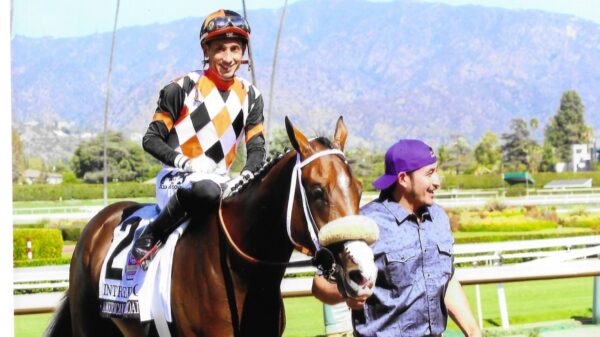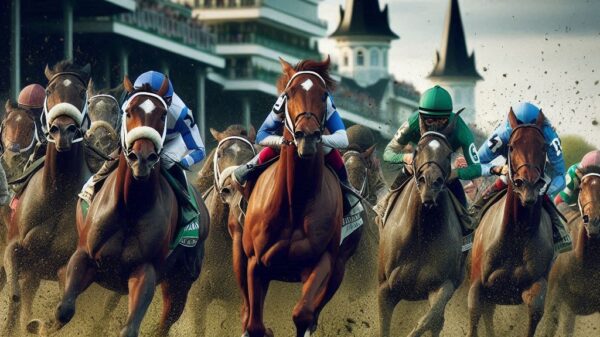
Rinaldo Del Gallo, III
By: Rinaldo Del Gallo, III
I have to admit that I was rooting Rated R Superstar to win the Razorback for purely sentimental reasons—he is ten. At 24-1, much more than his 15-1 morning line odds, he was a fair price. Had he come in third, an even across the board bet might have yielded a profit. He is entered in the Essex Handicap (race 9) this Saturday at Oaklawn Park.
Rate R Superstar wins the 2022 Essex at age 9
But I am not writing about handicapping—I am writing about policy. You see, Rated R Superstar is a 10-year-old horse. This was his 67th start in a career where he faced the starter 66 previous times, won 13 of those races, was second 10 times and third 9 times. He has an in the money percentage of 48.48%, slightly under half.
According to the Daily Racing Form, Rated R SuperStar made his debut July 25, 2015, at Ellis Park for maiden 2-year-olds. That day he took the lead early but couldn’t hold on, a form that would be opposite of his come rushing late with one big charge tactic of his later life. Of the nine horses that started in the 2023 Razorback, literally only the 8-year-old gelding KEYSTONE FIELD (USA) dkb/br. G, 2015 {3-l} would have been alive at the time of Rate R Superstar’s birth, and he would have been a young foal at his mother’s side. The horse that won the Razerback, LAST SAMURAI (USA) ch. H, 2018 {1-n}, hardly a “youngster” at age 5, would literally not be born for three years when Rated R Superstar started his first race.
When we start talking about older horses that are still racing successes, usually the story of great geldings come out, for the intact males and mares have been sent to the breeding shed long before age 9 or 10. JOHN HENRY (USA) br. G, 1975 {8-c} won a stakes race at age 9, when he won the 1984 Ballantine Scotch Classic in his last race on October 13, 1984 for a $900,000 purse. The announcer exclaimed, “The old man John Henry takes command” as was heading down the stretch of the Ballantine Scotch Classic.
Ballentine Scotch Classic 1984
In fact, John Henry won 4 Grade 1 races in 1984 when he was 9 (the Grade 1 Hollywood Invitation Handicap on Turf, the Grade 1 Sunset Handicap on Turf, the Grade 1 Budweiser Arlington Million on Turf, and the Grade 1 Turf Classic at Belmont). Also at age 9, in 1884, John Henry won the Grade 3 Golden Gate Handicap. According to the DRF records available at the National Racing Hall of Fame, John Henry ran 9 times at age 9 in 1984. His other races included a 3rd, ¾ of a length back in the Grade 3 San Luis Rey on turf. He started his 9 year old season in the Grade 1 Santa Anita Handicap John Henry was fifth, 8 lengths back—making it seem like 9 years of age was too old—but John Henry was never out of the money in the rest of his 7 remaining starts.
In 2017, I wrote about Borrow’s big win in the 1917 Brooklyn Handicap at Old Aqueduct Park. In arguably the greatest race of all time, Borrow beat three Kentucky Derby winners (Old Rosebud, Regret, and Omar Khayyam), the favored Boots, Roamer (Hall of Fame), and the excellent Stromboli. Borrow was 9 years old when he beat one of the greatest fields ever assembled for a horserace.
https://www.thoroughbreddailynews.com/the-1917-brooklyn-a-race-for-the-ages/
There are some people that assert older horses should not run, and when GREY LAG (USA) ch. H, 1918 {13-b} proved to be infertile he ran in claiming races in Canada as a 9- and 10-year-old horse—apparently this was quite a scandal.
THE NEW YORK RACING ASSOCIATION BAR AGAINST HORSES 10 OR OLDER RUNNING
On Feb 26, 2021, David Grening wrote a story for the Daily Racing Form, “Horses 10 and up soon will not be allowed to run at NYRA tracks.” The article stated, “According to Keith Doleshel, the racing secretary at Aqueduct and assistant racing secretary at Belmont and Saratoga, it was a rule borne out of equine safety and welfare. ‘In the last couple of years we’ve had a couple of 10-year-olds and up break down,’ Doleshel said.
Apparently, racing at age 10 or older is not that common. The article continues, with more quoting of Keith Doleshel, “There are three horses who raced at Aqueduct in 2020 who are 10 or older, including Mills, an 11-year-old who won an $8,000 claimer here on Jan. 18. Most recently, he finished fourth at that same level on Feb. 4.”
Which brings me to my first question—what science is there that teaches it might be more dangerous for ten years old and up to race? On the other hand, if there are only “three horses who raced at Aqueduct in 2020 who are 10 or older,” and yet, “in the last couple of years we’ve had a couple of 10-year-olds and up break down,” that is powerful evidence that running at age 10 might not be safe—but it is a wicked small sampling body and much more correctly called “anecdotal evidence” than a broad range study. For years there have been complaints there is not a good, industry-wide collection of data. Sound policy is based on industry-wide studies, not anecdotal evidence.
The fact is there is no study I can refer to as to how the 10-year rule came out. There was an article written about BACKSIDEOFTHEMOON (USA) b. G, 2012 {1-n} by Bill Finley, of the Thoroughbred Daily News, Wednesday, January 26, 2022, saying that the 10-year-old was being sent to PARX because of NYRA’s 10-year-old and over ban. When I looked at Equibase to see how BackSideOfTheMoon was doing, it indicated he earned a little over $138,186 in 2022 racing at age 10—hardly a cripple. He was 3rd in an allowance race at Parx, first in an allowance optional claiming race at Churchill Downs (a $134,000 purse), first in another claiming race at Churchill Downs ($62,000 purse plus another 10 grand in Kentucky development funds) and was second in a claiming race at Keeneland ($61,000). BackSideOfTheMoon was far from some dud that had no business racing.
https://www.equibase.com/profiles/Results.cfm?type=Horse®istry=T&refno=9277760
Bill Finley’s article reads, “When asked for comment, NYRA spokesman Pat McKenna provided the following statement: ‘Horses 10 years of age or older are ineligible to be stabled or compete in races at Aqueduct Racetrack, Belmont Park and Saratoga Racecourse. This NYRA rule was implemented in April to enhance equine safety and remains in place today.’” Who isn’t for enhancing equine safety? But there is no explanation of what data was gathered to show that 10-year-olds cannot run safely.
My role in horse racing is solely one of fan, and one that is concerned with animal welfare. It is a bit off topic, but where I am from, I have contributed to passing local legislation for animal safety and welfare. Click on articles HERE and HERE for some of a number of examples. Years back, before the local bans on pet stores from selling puppies from puppy mills, I passed local legislation to give farm animals enough room to turn around. Eventually, this was passed by statewide ballot in Massachusetts. On June 5, 2019, my piece, “Adopt or Perish” was published by Thoroughbred Daily News, which you can read HERE. My point is that my description of myself I provided in that TDN article, “what many in the animal-rights community might call an oxymoron–an animal rights activist who loves horse racing,” is spot on.
So why am questioning whether a policy aimed at equine welfare is necessary or even useful? I think I have the credentials to clearly indicate that I am not someone that is calloused to animal welfare.
Recently, I posted a poll on Facebook that read as such:
Rate R Superstar is 10 years old and is entered in the Grade 3 Razorback Handicap at Oaklawn this weekend. NYRA has outlawed horses racing that are ten years or older.
POLL: Should Oaklawn have a similar rule and disqualify Rated R Superstar from participating in racing at their track because the horse is 10 years of age?
It was posted in the group “Thoroughbred Horse Racing Discussion” which contains many readers to this publication. Almost all members are hardcore racing fans, and many are also in the industry. The poll had a staggeringly high response of 307 people in 3 days—this is highly statistically significant because so many people replied. Of those 307-responding people, 94% (no, that is not a typographical error) responded to whether Rate R Superstar should be banned because of his age, “No. So long as the horse is healthy, the horse should be able to run, even if he is 10 or older.” Only 5% of responders responded, “Yes. Rate R Superstar should be disqualified because he is 10 years old. Horses 10 or older should not race.” 1% responded “no opinion.” Imagine that, when you ask 307 people that are big fans or highly involved in the industry if a 10-year-old ought to be able to run, 286 will say let horses 10 years old or older run, 16 will say 10 is too old, and 5 will have no opinion.
Can you think of any other rule implemented by the horse racing industry itself (the New York Racing Association) that 94% of an audience of serious race fans and people in the industry disagree with? I can’t think of another. Humility requires us to take such a one-sided position by those who regularly follow racing or might even own a horse or earn their livelihood in racing seriously. This was a poll in which 307 people responded, not 30 people—it is very statistically relevant.
The New York Racing Association might have a great case to stop horses 10 years old or older from racing, but it has not really made it yet. There are stories of great geldings breaking down in their old years, such as Hall of Fame horse OLD ROSEBUD (USA) b. G, 1911 {6-a}, a horse that saw the starters gate 80 times. Old Rosebud broke down on the racetrack, on May 17, 1922, when he stepped in a divot (according to the Hall of Fame) while racing at the Jamaica Racetrack. He was put to sleep on the 23rd. When I look at Old Rosebud’s past performances available from the Hall of Fame, I see such races as a handicap of $1863 won by TIPPITY WITCHET (USA) b. G, 1915 {31} on the 12th of November 1919, a year and a day after the Armistice ending World War I. Tippity Witchet, a gelded son of Broomstick that raced 266 times, won 78 times, had 52 Places and 42 Shows. By way of comparison, Kingston had 89 wins in 138 starts. 78 wins is near the highest of all time. Pedigree query dot come has Tippity Witchet with the 4th highest of all time for North American wins.
According to an article in Thoroughbred Racing Commentary, Salute these two forgotten heroes of American racing, published January 21, 2022:
Tippity Witchet raced from 2 until the age of 14. He won at 27 of the 31 racetracks he competed on. He raced in Mexico in Canada and in Cuba, he won on fast ground and in the mud, he won over 6 furlongs and he won over a mile and a half, he won multiple stakes and numerous claimers, often changing hands, and he kept racing, and he kept winning.
At the age of 12 he won 12 races.
Again, Tippity Witchet won 12 races at age 12! According to Wikipedia,
On January 22, 1928, The Washington Post wrote: “Perhaps no horse more deserves the title of selling plater king of the American turf than Tippity Witchet, the 12-year-old in Broomstick’s famous thoroughbred family. For eleven seasons Tippity Witchet has been an active campaigner, and his record for 1927 is as impressive as his achievements in his younger days.”
His last race took place on February 1, 1929. By the time he retired, he had competed on racetracks in the United States, Canada, Mexico, and Cuba. His record stood at No. 4 in the all-time greatest number of North America wins. In his last year, he was fourteen and still winning.
Arguably, the breed is less sturdy than it was 100 years ago, but I must confess I see many race records of horses running for small purses that have run 60 times. Sure, Tippity Witchet can be dismissed as outlier and anecdotal evidence. But he is hardly alone.
But turning back to Old Rosebud, while he was euthanized days after his mishap on May 17, 1922, he was always a horse that was susceptible to injury. He is often recorded as the unofficial champion 2-year-old of 1913 and the unofficial champion handicap horse of 1917—note the four-year difference. What is amazing is a gap in Old Rosebud’s past performances. If you look at Old Rosebud’s past performances, he won the Kentucky Derby by 8 lengths on May 9, 1914, the second Saturday in May and not the first as is today’s tradition. Old Rosebud then ran in the Withers run May 30, 1914, at Belmont Park, and according to the DRF records, “bore out far turn.” The New York Times reported, “If every blade of blue grass withers in Kentucky tonight it will be little surprise to horse lovers. For Old Rosebud, winner of the historic Kentucky Derby less than a month ago, was made to look like the commonest sort of selling plater in the race for almost equally historic Withers Stakes for three-year-olds at Belmont Park track yesterday.”
I would like the reader to get this. The Withers was May 30, 1914. Old Rosebud’s next race according to the DRF past performances offered at the Hall of Fame was a handicap on February 18, 1917, at Juarez, Mexico, where he started off his career. There was no typographical error. May 30, 1914, until February 18, 1917. This is a gap of 996 days from the start date to the end date, end date included. Put another way, this is a gap of 2 years, 8 months, and 20 days. Or put yet another way, it is a gap of 32 months, 20 days including the end date. It is a gap of time longer than many racing careers. It was not the only major gap. On September 17, 1917, Old Rosebud won the Bayview Handicap at Aqueduct in New York. His next race would be April 25, 1919, when he won a $1176 allowance race at Havre de Grace racetrack in Maryland. This was 586 days; or put another way,1 year, 7 months, 9 days, or put another way, 19 months and 9 days.
Old Rosebud was one very injured horse, and how he got it in 80 starts with such gaps in his running is a story in and of itself. Born in 1911, Old Rosebud was killed while running in 1922 at the age of 11 years old. He had only run twice in 1922—the other 11 days earlier in a claimer at Jamaica Racetrack. So, yes, Hall of Famer Old Rosebud did die on the racetrack at age 11. That said, a case could be made that Old Rosebud was not sound enough to be running in the first place. The DRF maintains that the race did not kill him, but a workout later: “Days later, the diminutive gelding returned to the course for a morning gallop when an age-old tragedy unfolded: One bad step, a deep head bob, a sharp tightening of reins, rapid deceleration, and a staggering, three-legged halt.” DRF’s The story of Old Rosebud, an American tragedy, published in 2014 and available online is a worthy read.
Turning to this year’s Razorback, Rated R Superstar raced from the back of the pack, perhaps was too far back and left too much to do but ended up a respectable 4th in a field of 8 horses. Sure, there were 12 lengths between him and the winner, but there was only 3 ¾ lengths between him and the third-place horse. I am not trying to argue that a horse that lost by 12 lengths ran particularly well, but his fourth-place finish in that field of 8 horses wasn’t the kind of race that causes wonder why he was entered in the race in the first place. Rated R Superstar beat the 4-year-old Hero Status. Rate R Superstar ran a totally normal race, suggesting that a rule banning 10-year-olds from racing may not have merit.
I am not going to say definitively that 10-year-old horses should run. But history and the consensus of so many people with a high degree of interest in the sport tend to indicate that while too many horses breakdown, being ten years of age does not seem to be the cause of it. Again, 94% of 307 respondents of people that are big racing fans, some of whom are also in the industry, believe there is nothing wrong with running a 10-year-old horse.
While the reader who is a fan of flat racing may not know it, a horse has to be seven years of age to enter the Grand National—any younger is too young. According to Wikipedia, the oldest horse to win the Grand National was 15 years of age when he won in 1853. Also, according to Wikipedia, “In 1923, Sergeant Murphy became the first U.S.-bred horse to win the race. He is also the joint-second oldest horse to win, at age 13, alongside Why Not (1884).” According to one article, “Nine years is the most common age of Grand National winners, accounting for 46 of the previous victors.” One would think that running in a steeplechase is more grueling than a flat race.
One website with a 2021 article lists the number of Grand National Winners by age since 1984. You have to be 7 to run, but no 7-year-olds were listed. There were five 8-year-old horses, ten 9-year-old horses, eight 10-year-old horses, nine 11-year-old horses, and three 12-year-old horses. Under the NYRA rule, 20 of these or 57.14% of the winners would not even have been eligible to run in the Grand National, because they were 10 years of age or older.
In a June 17, 2014, article published by Bloodhorse titled, 10-Year-Old Mare Becomes Stakes Winner, it was written “Six years after finishing second in the Southern Belle Stakes at Grants Pass Downs in Oregon, Chocolate Starr tried again in this year’s edition June 15 and scored a determined win, earning her first stakes victory at age 10.” Chocolate Star not only won, she now has children.
Perhaps if challenged, the New York Racing Association has a case that 10-year-old horses cannot safely run. But it has not made that case. The case needs to be made. I am open minded, but I am not going to believe something is true just because someone says it is true, without sufficient evidence. Bring on the big, longitudinal, industry-wide studies! And a strong animal rights activist is making the point. There are studies showing that horses have peak speed at certain ages which can be read HERE. But I know of no study suggesting that horses that run at age 10 in flat races are more susceptible to injury than their younger counterparts. If there is one, please bring it to my attention.
UPDATE:
RatedRSuperstar finished 7th in the Essex, a race he won last year. A $1 bet would have yielded a $27.90 profit, so the clear consensus is that he was not the horse he was last year at age 9. Still, he beat the 6 year old stakes winning NECKER ISLAND (USA) ch. H, 2017 {1-w} and the 4 year old CALL ME FAST (USA) dkb/br. G, 2019 {16-f} who has earned $255,509. Again, the point is not that RatedRSuperstar was in the shape he was last year—the point is that this was not a horse on the precipice of breaking down, losing by 40 lengths.








